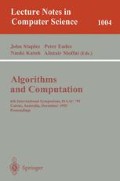Abstract
Given a set S of n points in the plane, a quadrangulation of S is a planar subdivision whose vertices are the points of S, whose outer face is the convex hull of S, and every face of the subdivision (except possibly the outer face) is a quadrilateral. We show that S admits a quadrangulation if and only if S does not have an odd number of extreme points. If S admits a quadrangulation, we present an algorithm that computes a quadrangulation of S in O(n log n) time, which is optimal, even in the presence of collinear points. If S does not admit a quadrangulation, then our algorithm can quadrangulate S with the addition of one extra point, which is optimal. Finally, our results imply that a k-angulation of a set of points can be achieved with the addition of at most k-3 extra points within the same time bound.
research supported by Killam and NSERC postdoctorate fellowships and grants NSERC-OGP0009293 and FCAR-93ER0291.
Preview
Unable to display preview. Download preview PDF.
References
Arkin, E., M. Held, J. Mitchell, and S. Skiena, Hamiltonian triangulations for fast rendering, Algorithms-ESA'94, J. van Leeuwen, ed., Utrecht, NL, LNCS 855, pp. 36–47, September 1994.
Bondy, J. and U.S.R. Murty, Graph Theory with Applications. Elsevier Science, New York, New York, 1976.
Bose, P. and G. Toussaint, No Quadrangulation is Extremely Odd. Tech. Rpt. 95-03, Dept. of Comp. Sci., University of British Columbia, Vancouver, Canada, 1995.
Chazelle, B., On the convex layers of a planar set, IEEE Transactions on Information Theory, IT-31, pp. 509–517, 1985.
Everett, H., W. Lenhart, M. Overmars, T. Shermer, and J. Urrutia, Strictly convex quadrilateralizations of polygons, in Proceedings of the 4th Canadian Conference on Computational Geometry, pp. 77–83, 1992.
Hershberger, J., and S. Suri, Applications of a semi-dynamic convex hull algorithm, in Proceedings of the second S.W.A.T., Lecture Notes in Computer Science 447, Bergen, Sweden, pp. 380–392, 1990.
Kahn, J., M. Klawe, D. Kleitman, Traditional galleries require fewer watchmen, SIAM J. Algebraic Discrete Methods, 4, pp. 194–206, 1983.
Lai, M., Scattered data interpolation and approximation by using C 1 piecewise cubic polynomials, submitted for publication.
Lai, M., and L. Schumaker, Scattered data interpolation using C2 piecewise polynomials of degree six, Third Workshop on Proximity Graphs, Mississippi State University, Starkville, Mississippi, December 1–3, 1994.
Lubiw, A., Decomposing polygonal regions into convex quadrilaterals, in Proceedings of the 1st ACM Symposium on Computational Geometry, pp.97–106, 1985.
O'Rourke, J., Computational Geometry in C, Cambridge University Press, 1994.
Preparata, F., and M. Shamos, Computational Geometry: An Introduction, Springer-Verlag, New York, 1985.
Sack, J., and G. Toussaint, A linear-time algorithm for decomposing rectilinear star-shaped polygons into convex quadrilaterals, Proc. 19th Annual Conf. on Communications, Control and Computing, Allerton, pp. 21–30, 1981.
Sack, J., and G. Toussaint, Guard placement in rectilinear polygons, in Computational Morphology, G. Toussaint, ed., North-Holland, pp. 153–175, 1988.
Toussaint, G., Solving geometric problems with the rotating calipers, Proc. IEEE MELECON 83, Athens, Greece, pp. A10002/1–4, 1983.
Author information
Authors and Affiliations
Editor information
Rights and permissions
Copyright information
© 1995 Springer-Verlag Berlin Heidelberg
About this paper
Cite this paper
Bose, P., Toussaint, G. (1995). No quadrangulation is extremely odd. In: Staples, J., Eades, P., Katoh, N., Moffat, A. (eds) Algorithms and Computations. ISAAC 1995. Lecture Notes in Computer Science, vol 1004. Springer, Berlin, Heidelberg. https://doi.org/10.1007/BFb0015443
Download citation
DOI: https://doi.org/10.1007/BFb0015443
Published:
Publisher Name: Springer, Berlin, Heidelberg
Print ISBN: 978-3-540-60573-7
Online ISBN: 978-3-540-47766-2
eBook Packages: Springer Book Archive

